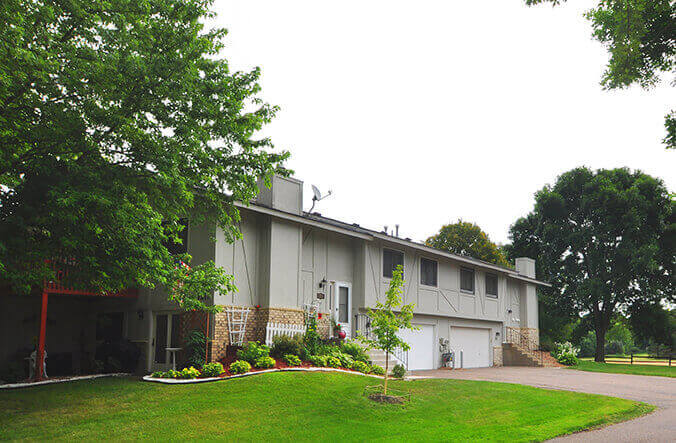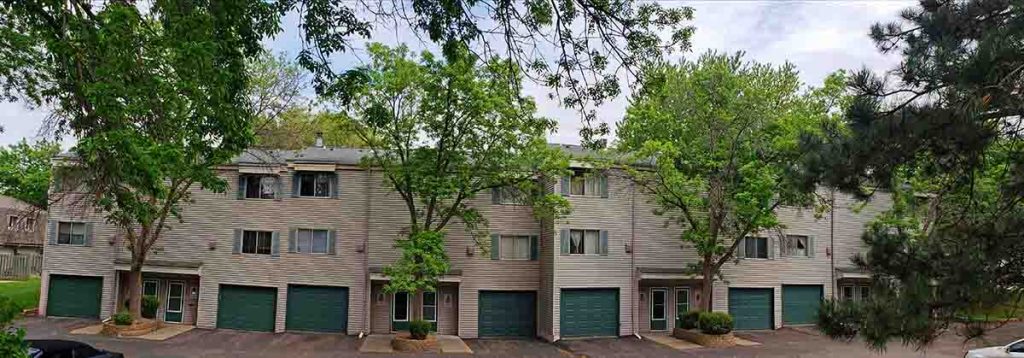Cimarron Home Owner’s Association Joins Sharper

Eden Prairie, Minn – (August 17, 2018) – Effective August 1st, Sharper Management is pleased to have taken over full management services for the Cimarron Home Owners Association in Chanhassen. The Cimmaron development is a large 156-unit quad home community built in the late 70s-early 80s.. “We are very please to have the opportunity to step in to the Cimarron development,” said Matt Froehlich, Owner and Chief Operating Officer of Sharper Management. “It is a large association on a large lot of land. As a 40-year old community, they have reached that critical age where maintenance and revitalization is their key focus. We look forward to working with the Board to help them continue to make Cimarron a wonderful community association.” Founded in 2010, Sharper Management is a locally-owned, mid-sized property management company offering a full suite of premiere services to homeowner and commercial associations of all sizes. Sharper Management currently provides services to the Minneapolis-St. Paul seven-county area.
How Association Boards and Management Companies Work Together

In an HOA, there is often confusion about who is responsible for what between the Board and Management Company. While each association and their contract with a management company is unique, we have gathered some general guidelines to help clarify these roles. The HOA and its Board are responsible for the overall operations of the community. The Board makes all decisions regarding rules and they are responsible for maintaining the value of the property through maintenance, collecting dues, paying bills, and filing taxes. The confusion often comes into play because Boards delegate certain responsibilities and administrative tasks to management companies. In a nutshell, the management company carries out the directives of the Board as their administrative arm. Management companies do not set policy. Full-service and financial-only management contracts can further add to misinterpretation of responsibilities of a management company. A full-service contract will include things like general maintenance of the association’s common areas, financial and administrative duties such as paying the bills and collecting dues, and tasks such as facilitating meetings and taking/distributing notes and notifications to residents. A financial-only contract for management is just that. The management company takes care of things relating to finances such as paying the bills, managing dues and collections, and management of the reserve fund. With many different options and the unique needs of each association, it’s easy to see why questions arise regarding who is doing what!
Board Tips: Overcoming Decision Making Paralysis

There is nothing more frustrating for members, managers, and even homeowners than a Board that is collectively stuck in the muck, endlessly spinning their wheels deeper in the rut of indecision. Rest assured, it is a common condition. If it is not a recognized medical disorder, it should be! Perhaps it is a large construction project, a delicate homeowner situation needing resolution, a complicated budget crisis, or maybe a vendor change. Many things are thrown at Boards – and often times it is difficult to get to that point where you are ready for the all-important motion to vote. There are three things that may help you as an individual Board member, and as a collective group. Accept that you will never have 100% satisfaction from stakeholders. Often, time on the Board means time spent making tough decisions that are best for the Association as a whole. Don’t let chronically complaining Cathy dictated construction projects. A needed special assessment can’t be derailed because it will break broke Bob’s bank account. Accept that designer Debbie doesn’t do blue and won’t like those new shutters. The sooner you realize unanimous acceptance is rare, if not impossible, the sooner you can move on to make necessary decisions. Realize that Board consensus can be difficult to achieve and accept that it is OK. The more complicated the topic, the more likely you are to have varying opinions. Naturally, it is good to hash it out. Consider all angles. However, at some point you’ve got to call the vote. Which brings us to our final point. Have a good facilitator among the group. There is nothing more important to group dynamics than for someone to take on the role of task master. Perhaps it is the President acting as the Chairman. Sometimes it is the Community Manager being the neutral party helping facilitate the meeting along. Whomever it may be, a group needs this person! Their primary skill should be recognizing when a debate is over or just plain unproductive, and calling the subject to a vote for resolution. All too often decisions get “tabled” for the next meeting. If it gets “tabled” once – you may as well just move on entirely. You’re probably stuck on the two points mentioned above and will always be there. We’re sure you can now see how these points all work together! Consider these remedies for decision making paralysis and hopefully you can be a more productive Board by making decisions and moving forward with your Association’s projects and initiatives!
HO6 Policy Overview

After making the decision to join a homeowners association, your next step should be to protect all of your home assets. Overall, there are two main insurance policies necessary to cover a property loss: a master policy through the association and personal homeowner policy (called an “HO6”). The master policy is provided by your association and can vary in coverage. Generally, it always covers the exterior shell of the building/home and common areas. The interior of the unit/home, however, varies. It is very important that you understand the scope of coverage required by the association’s governing documents and therefore covered by the master policy. “Walls In,” “Studs Out,” “All In,” “All In, Less Betterments and Improvements” are common terms that mean very different things. Often times the structural coverage of the HO6 policy is called “Coverage A” or “Real Property Coverage.” This would cover damage to the unit that is either A.) not covered by the master policy or B.) from a loss that may not reach the association’s deductible. The amount of “Coverage A” that you should carry will vary, so you and your personal insurance agent should look to the master policy to identify possible coverage gaps and recommended amounts. Another part of your HO6 policy should usually include Liability; in many cases, this type of coverage is an umbrella policy. Should someone hurt themselves on your property, your insurance would cover the medical expenses. Liability claims can lead to expensive lawsuits that involve you and the association, so an HO6 protects you from the financial strain that follows those type of events. If your unit is left empty for long stretches of time, there could also be a tailored coverage for that situation. Finally, you should look to add “Loss Assessment” coverage to your HO6 policy and check your association’s governing documents, as it may be a requirement. Loss Assessment would cover you in the event the association assesses you for a deductible or for damages caused to Association property. Association insurance can be complicated, so you should utilize your agent to help navigate coverage needs. Furthermore, don’t be afraid to tell your agent to work with the association’s agent to ensure all possible coverage gaps are closed.
McKnight Townhomes and Condos Joins Sharper Management Family

Eden Prairie, Minn – (June 6, 2018) – Effective April 1st, Sharper Management is pleased to have taken over full management services for the McKnight Townhomes Condominium Association in Maplewood. Originally constructed in 1972 as a rental townhome community, it was converted to a cooperative in 1983, and then to a condominium association in 1993. McKnight is an expansive 32-building community with a total of 190 three-story homes “The sheer size and scope of McKnight is a lot to take in,” said Matt Froehlich, Owner and Chief Operating Officer of Sharper Management. “However, we have the tools and the talent to work with a very knowledgeable and dedicated Board to further enhance the resident experience and property value of the community. We are grateful for the opportunity to work with McKnight.” Founded in 2010, Sharper Management is a locally-owned, mid-sized property management company offering a full suite of premiere services to homeowner and commercial associations of all sizes. Sharper Management currently provides services to the Minneapolis-St. Paul seven-county area.
The Three “P’s” of Decision Making

When it comes to the decision-making process, Board members should check the three P’s. Policy. Practice. Precedence. No matter how large the decision or how small the conversation, Board members should be methodical and intentional throughout their discourse. Policy – this is the easy one. When making decisions, responding to homeowner requests and issues, applying, and enforcing rules, or creating new policies, the Board should check the governing documents to see what policies, ordinances, laws, etc. that may apply. The governing documents are the playbook to how the association is governed and managed. Practice – where policy may not exist, the Board should be aware of past practices. A good example of this would be how Limited Common Elements are handled. Does the association take on the expense of replacing the patio slab and then bill it back to that benefiting homeowner? Does the association treat it as a common expense and absorb it? Does the association make a list each spring of the patio slabs to be replaced and then replace them at the same time? Limited Common Elements and how they are handled can be a good example of something that the association may not have a written policy for (the governing documents typically give the association options), which makes it all the more important that the Board’s past practice is consistently followed. Another example might be how homeowners are incorporated into a Board meeting. Does the association have an “open forum” part of the meeting? Do homeowners need to email the Board or Management prior to the meeting to be put on the agenda? It is also wise for a Board to review their common practices and consider incorporating it into policy for continuity sake. Adding Board meeting conduct and procedures to the Rules & Regulations being an example. Past practice is what can get Boards into trouble. Often times it is wise to make practice in to policy. Precedent – at the end of the day, policy, and practice all goes to set what the Board should keep in the back of their mind. Whatever you do or decide today will set an all-important precedent. The best litmus test a Board can do for themselves is to ask – if we allow this homeowner request, change this service, engage this contract, etc. – will we and all Boards to follow do it every time? The three P’s all come full circle. Policy leads to Practice. Practice is your Precedence. Or…. Practice should lead to Policy, which sets Precedence. Whatever order it might take, when going through the decision-making process, check the three P’s.
Metro Lofts Joins the Sharper Management Family

Eden Prairie, Minn – (May 22, 2018) – Effective March 1st, Sharper Management is pleased to have taken over full management services for the Metro Lofts Condominium Association – a mixed use building off of the light rail line on University Avenue in St. Paul. Incorporated in 2006, Metro Lofts is a unique five-story, 67 unit condo building with commercial space on the lower level. Snap Fitness and Dunn Bros. Coffee make up the north section lower level of the building. “Metro Lofts is a beautiful building in a wonderfully re-developed area of the Twin Cities,” said Dan Cunningham, Owner and President of Sharper Management. “The Board of Directors have worked hard to navigate some unique circumstances – and we are honored they have entrusted us to help move the association forward. We look forward to a long relationship.” Founded in 2010, Sharper Management is a locally-owned, mid-sized property management company offering a full suite of premiere services to homeowner and commercial associations of all sizes. Sharper Management currently provides services to the Minneapolis-St. Paul seven-county area.
Part 4 – Rules & Regulations – Understanding Governing Documents for HOAs

Living in a homeowners association, you’ve likely heard people use terms such as “Bylaws,” “Rules” or “CC&Rs.” What do they mean? An Association is actually a registered non-profit corporation in the state of Minnesota – and to be so, they have an important set of legal governing documents. Much like our country has a Declaration of Independence, Constitution, Bill of Rights, etc to function as a nation, an association has a similar document framework to act as a common interest community. The purpose of this article is to give you, as a member of a homeowner association, a basic understanding of this set of documents. Although all HOAs are slightly different, their governing documents will typically all contain the following: * Articles of Incorporation * Declaration of Covenants, Conditions and Restrictions *CC&Rs) * Bylaws * Rules and Regulations Rules & Regulations So now that the Articles have incorporated a community association, the Declarations created a framework for rights and responsibilities and a “contractual” obligation between parties, and the Bylaws empowered the Board to create policies – now comes the document that helps regulate the day-to-day issues in an effort to maintain harmony between neighbors and between owners and association. Examples of common Rules include the following: * Pet regulations * Parking restrictions * Architectural guidelines and procedures * Holiday decoration limitations * Noise and nuisance parameters * Rental requirements * BBQ grill ordinance Each governing document serves a specific purpose, yet they all interact with one another to create and maintain a community homeowner association. By purchasing in an association, you created a legally binding contract between yourself and the association. That “contract” is the important documents listed above. Hopefully this breakdown is helpful. You can access these documents on your association’s website through www.sharpermanagement.com
Part 3 – Bylaws – Understanding Governing Documents for HOAs

Living in a homeowners association, you’ve likely heard people use terms such as “Bylaws,” “Rules” or “CC&Rs.” What do they mean? An Association is actually a registered non-profit corporation in the state of Minnesota – and to be so, they have an important set of legal governing documents. Much like our country has a Declaration of Independence, Constitution, Bill of Rights, etc to function as a nation, an association has a similar document framework to act as a common interest community. The purpose of this article is to give you, as a member of a homeowner association, a basic understanding of this set of documents. Although all HOAs are slightly different, their governing documents will typically all contain the following: * Articles of Incorporation * Declaration of Covenants, Conditions and Restrictions *CC&Rs) * Bylaws * Rules and Regulations Bylaws Once an association has been formed and the Declarations laid out, it then adopts a set of bylaws. Bylaws are important for owners. The primary function of the Bylaws is to give direction on how the Association will be governed. Here are some examples of critical components of the Bylaws: * Board of Directors structure (term length, number, qualifications, etc.) * Responsibilities of the Board (policy creation and enforcement, budget setting, etc.) * Officer positions and responsibilities (President, Treasurer, Secretary, etc.) * Voting procedures and rights * Board and owner meeting requirements * Meeting notice procedures Each governing document serves a specific purpose, yet they all interact with one another to create and maintain a community homeowner association. By purchasing in an association, you created a legally binding contract between yourself and the association. That “contract” is the important documents listed above. Hopefully this breakdown is helpful. You can access these documents on your association’s website through www.sharpermanagement.com
Part 2 – CC&Rs – Understanding Governing Documents for HOAs

Living in a homeowners association, you’ve likely heard people use terms such as “Bylaws,” “Rules” or “CC&Rs.” What do they mean? An Association is actually a registered non-profit corporation in the state of Minnesota – and to be so, they have an important set of legal governing documents. Much like our country has a Declaration of Independence, Constitution, Bill of Rights, etc to function as a nation, an association has a similar document framework to act as a common interest community. The purpose of this article is to give you, as a member of a homeowner association, a basic understanding of this set of documents. Although all HOAs are slightly different, their governing documents will typically all contain the following: * Articles of Incorporation * Declaration of Covenants, Conditions and Restrictions *CC&Rs) * Bylaws * Rules and Regulations The Declaration of Covenants, Conditions and Restrictions (CC&Rs) After a developer has established an association and incorporates it, then they must file an important document with the County that lays out the rights and responsibilities of the association and the people within it. It is truly the “meat” of the association’s set of governing documents – and it sets the framework for every other document after it. Some of the common components of the Declarations include: * Definition of Unit boundaries * Identifying “common areas” and components * Listing of maintenance responsibilities (ex: owners maintain inside of “unit” and association “common areas”) * Overall rights of owners (ex: unit leasing or pet) * Owner restrictions (ex: residential use only and not business) * Overall rights of association (ex: rule creation) * Insurance requirements * Assessment procedures and requirements (special assessments, monthly assessments/”dues”) * Association’s powers to collect dues The Declaration of Covenants is, in essence, the contract between owners and the Association. It is an incredibly important and powerful legal document. Each governing document serves a specific purpose, yet they all interact with one another to create and maintain a community homeowner association. By purchasing in an association, you created a legally binding contract between yourself and the association. That “contract” is the important documents listed above. Hopefully this breakdown is helpful. You can access these documents on your association’s website through www.sharpermanagement.com
